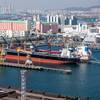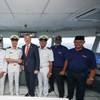Versatile, small high-speed craft are becoming an essential tool for modern naval and paramilitary forces, however the roles of these vessels are expanding. Rolls-Royce's Andrew Rice looks at the evolution of the Combat Boat 90.
More than 10 years ago, revised Swedish defense planning called for a radical increase in the mobility of coastal defense forces. As a result, the Combat Boat 90 project began, developed by the Swedish Defense Material Administration (FMV). A concept that is proving to be a world beater.
The prototype contract for two units required Swedish shipyard Dockstavarvet to produce all calculations and engineering/construction drawings based on the FMV project design. Within 10 months of contract award, trials on the first prototype were a success. The boat fulfilled all requirements with broad margins and the system test period was cut from 12 to six months. As a consequence, the first production batch of 12 boats commenced ahead of schedule. So successful has the Kamewa aluminum water jet-driven design become that hundreds of examples of the boat have been built for the Swedish forces and for export, including 147 for the Royal Swedish Navy, who will take their final deliveries next year.
Today, the high-speed aluminum hull form is to be found carrying out a wide range of tasks including peace keeping and anti-drug operations in locations around the world. It is interesting that present production boats are almost unchanged, except in detailed design and performance. The standard engine rating has risen from 2 x 460 kW to 2 x 500 kW, and with continuous improvements in Kamewa waterjet technology, loaded top speed is now more than 40 knots. Fitted with the optional higher engine rating of 2 x 590 kW, light ship performance is around the 50-knot mark.
The electronic package has been modified, and includes an integrated digital global positioning and radar, linked to a sophisticated command system plus intercom and external communications. Detailed engineering refinements incorporate lessons learned during more than 200,000 hours of actual operational experience. In analyzing the combat boat's rousing success, Karl-Anders Sundin, Dockstavarvet's managing director, said, "It is a combination of factors. We specialize in developing and building high-speed aluminum craft for a range of applications. Excellent maneuverability and a maximum continuous speed of 45 to 50 knots are important, and having a reinforced hull means that they can take some pretty rough treatment. The boats are quite light, and are easy to transport by road."
Speed and maneuverability prove to be a good combination when chasing criminals, and a bow ramp means that - when required - men can be put ashore for landing parties, quickly and easily.
The Combat Boat 90s are built to withstand the considerable rigors posed by duty in the Royal Swedish and Royal Norwegian Navy's operations in the Baltic and Arctic waters. The standard design has a displace- ment of 16 to 17 tons, fully crewed and tanked, and is capable of carrying 21 fully equipped soldiers, or up to 4.5 tons of cargo. The two Kamewa FF water jet propulsion units, each driven by a diesel engine, provide the speed and the maneuverability. The waterjets, which house all of the moving parts, allow for safe, shallow draft operation as well. They also eliminate the need for a heavy gearbox, as astern thrust is achieved by reversing the water discharge from the nozzles.
Heavy machine guns can be mounted in a fixed installation or stabilized and remotely controlled from a console in the wheelhouse. Regardless of its intended use - navy, coast guard, border patrol, anti-drug ops - Dockstavarvet is able to customize the vessel as required. For example, adding an extended 1.8 m bow ramp, forward deck, crane and a fire pump turns the combat boat into an agile firefighting vessel.
With the good references of success serving the Royal Swedish and Royal Norwegian Navies, Dockstavarvet has been exporting the technology, with the delivery of 40 combat boats to the Mexican Navy, and delivery of 12 boats for the Royal Malaysian Navy. Delivered in 2001, the contract included base maintenance systems and boat handling systems. The boats are used to police Malaysia's lengthy coastline, mainly in and around Sabah and Sarawak.
New versions continue to evolve as navies respond to changing roles, as they require more flexible fleets. After carefully evaluating two prototypes, the Swedish Navy is adapting the 27 Combat Boats remaining in build for international peace-keeping missions. The adaptation embraces three areas: personnel protection, biological/chemical protection and operation in a Mediterranean-type climate, and comes as the Swedish Armed Forces place an increased focus on international peace-keeping activities, as well as a demand from the UN to support joint international missions with personnel and material. Deliveries have commenced, and the final boats are scheduled to be in service by mid 2003.
The preceding was excerpted, in part, from Rolls-Royce The Magazine, Issue 93, June 2002. All photos courtesy: Ake Nordlander/Fredrik Forsman - Dockstavarvet AB.)
Sponsored Content
Safer Starts Here: Build Ships, Protect Crews

July 2025
 Read the Magazine
Read the Magazine

 Read the Magazine
Read the Magazine
This issue sponsored by:

Inside the U.S. Navy: The Fleet has to get Bigger, and that’s a Big Challenge
Subscribe for
Maritime Reporter E-News
Maritime Reporter E-News is the maritime industry's largest circulation and most authoritative ENews Service, delivered to your Email five times per week







